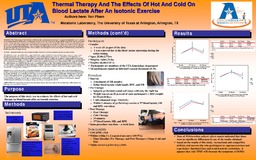
ATTENTION: The works hosted here are being migrated to a new repository that will consolidate resources, improve discoverability, and better show UTA's research impact on the global community. We will update authors as the migration progresses. Please see MavMatrix for more information.
Show simple item record
| dc.contributor.author | Pham, Yen | en_US |
| dc.date.accessioned | 2013-02-22T20:56:29Z | en_US |
| dc.date.available | 2013-02-22T20:56:29Z | en_US |
| dc.date.issued | 2013-02-22 | en_US |
| dc.identifier.uri | http://hdl.handle.net/10106/11344 | en_US |
| dc.description.abstract | Delayed-Onset Muscle Soreness (DOMS) describes a phenomenon of muscle pain or soreness that frequently occurs as a result of strenuous physical activity. DOMS occurs especially during the first few days after such activity. Because DOMS results in functional loss and related activity restriction, prevention and treatment are both important factors to recreational and competitive athletes, and to anyone who participates in vigorous exercises and activities of daily living. Lactic acid and its accumulation was once thought to be a major cause of DOMS, however this is not the case. Research suggested that blood lactate returns to resting levels within one hour of exercise even after extremely intense bouts of work. Thus the goal of this study was to determine the effects of two 10 minute thermal therapy between hot and cold, after an isotonic exercise, and the effect on blood lactate within a 30 minute interval. | en_US |
| dc.description.sponsorship | Wilson, Judy Ph.D. | en_US |
| dc.language.iso | en_US | en_US |
| dc.subject | Delayed onset muscle soreness | en_US |
| dc.subject | Blood lactate | en_US |
| dc.subject | Lactic acid | en_US |
| dc.title | Thermal therapy and the effects of hot and cold on blood lactate after an isotonic exercise | en_US |
| dc.type | Presentation | en_US |
| dc.publisher.department | Metabolic Laboratory, The University of Texas At Arlington | en_US |
| dc.publisher.department | Exercise Science Research Laboratories, The University of Texas at Arlington | en_US |
| dc.publisher.department | Department of Kinesiology, The University of Texas at Arlington | en_US |
Files in this item
- Name:
- Pham_ Poster.pdf
- Size:
- 1.030Mb
- Format:
- PDF
- Description:
- PDF
This item appears in the following Collection(s)
Show simple item record


